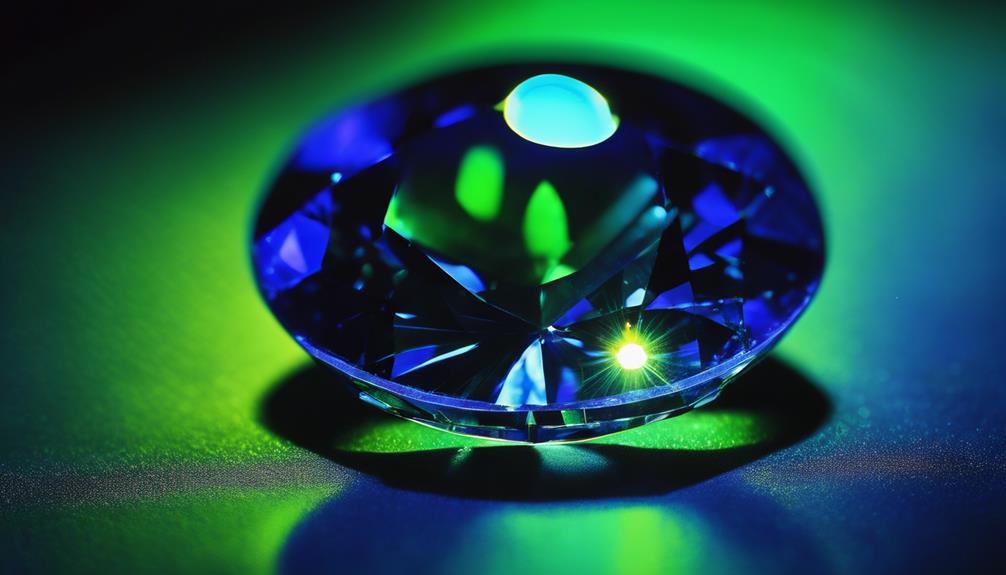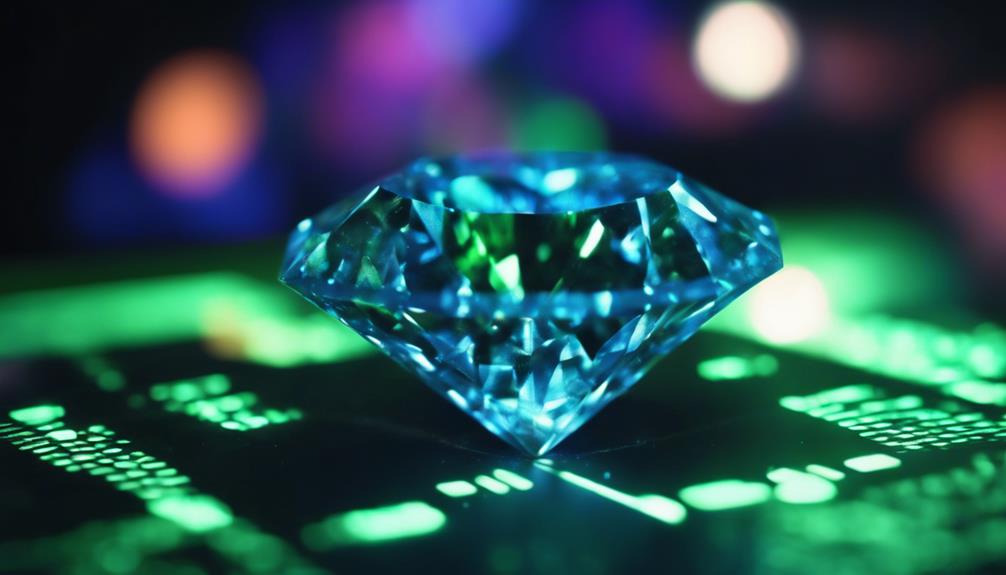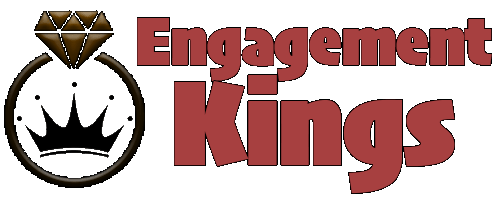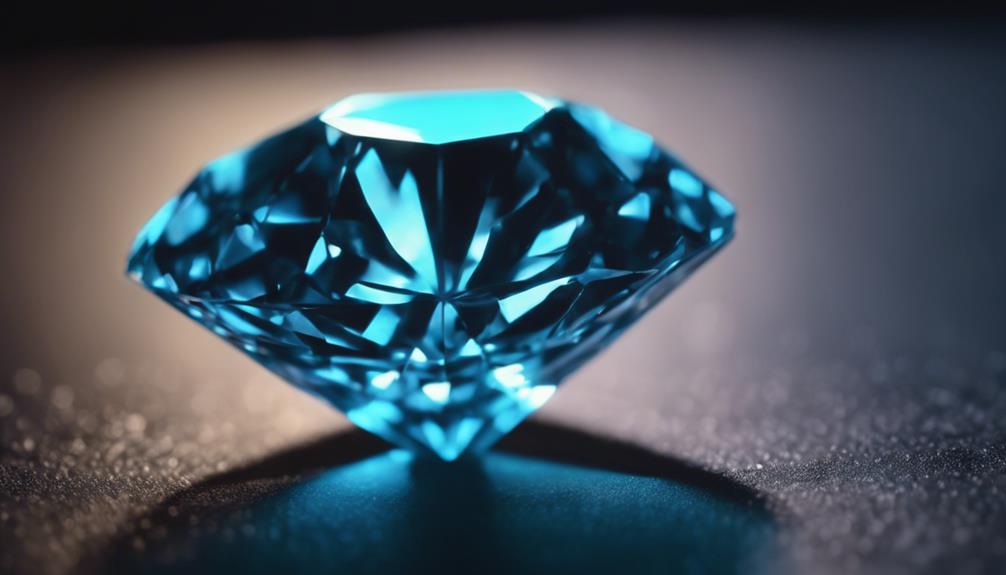Around 30% of natural diamonds show fluorescence, usually a mesmerizing blue glow under UV light. The Gemological Institute of America (GIA) grades this effect from None to Very Strong. Medium to Very Strong fluorescence can cause a noticeable blue hue, sometimes enhancing or reducing a diamond’s appeal. High-color grade diamonds (D, E, F) with strong fluorescence may appear milky, while lower grades could look whiter. Lab-grown diamonds usually lack this trait. Knowing a diamond’s fluorescence helps you make an informed purchase. There’s much more to reflect upon if you’re looking to understand how this affects beauty and value.
Understanding Diamond Fluorescence

Around 30% of natural diamonds exhibit fluorescence, characterized by a blue glow under UV light. This unique trait can make diamonds appear more vibrant in certain lighting conditions. The Gemological Institute of America (GIA) grades fluorescence on a scale from None to Very Strong. You’ll find that most natural diamonds fall somewhere in between.
The presence of fluorescence can impact a diamond’s visual appeal and value. For instance, a diamond with Medium to Very Strong fluorescence might display a noticeable blue hue when exposed to UV light. On the other hand, diamonds with Faint fluorescence generally show minimal changes.
When examining diamonds, it’s important to note that lab-grown diamonds usually lack fluorescence. This characteristic can be a helpful indicator when determining whether a diamond is natural or lab-grown. Additionally, understanding the different fluorescence levels can guide you in making an informed purchase.
In essence, fluorescence adds an intriguing dimension to diamonds. Whether it enhances the stone’s beauty or slightly impacts its clarity, knowing about fluorescence will help you make a more educated choice when shopping for diamonds.
Visual Effects
When you view a diamond with Medium to Very Strong fluorescence under UV light, you’ll notice a ghostly blue hue that can either enhance its beauty or create a hazy appearance. This intriguing effect is enchanting to some but can be off-putting to others.
In normal lighting, strong fluorescence might cause a diamond to appear slightly milky or oily, particularly in diamonds with high color grades like D, E, or F. However, it’s important to remember that not all fluorescence is detrimental. In fact, slight or faint fluorescence can make a near-colorless diamond look whiter, enhancing its visual appeal.
The blue glow can sometimes mask yellowish tints in lower color grades (like I or J), making the diamond appear more colorless than it actually is. Interestingly, studies by the Gemological Institute of America (GIA) reveal that most people can’t perceive fluorescence’s impact without knowing it’s there.
This means that, for many, the visual effects of fluorescence are negligible in everyday settings. So, while fluorescence might sound like a major factor, its actual visual impact is often much less significant than you might think.
Buying Considerations

Understanding the impact of fluorescence should be a key consideration when you’re buying a diamond. Fluorescence can either enhance or detract from a diamond’s appearance and value. Strong fluorescence might negatively affect the price, especially for high-color grades like D, E, and F. On the other hand, faint fluorescence can make diamonds appear whiter and might save you money without compromising brilliance.
When shopping, always buy from reputable retailers that provide GIA certification for their diamonds. This guarantees you’re getting an accurate assessment of the diamond’s quality, including its fluorescence. It’s essential to check the store’s return policies and request to view the diamond under both UV and normal lighting conditions. This way, you can see firsthand how the fluorescence affects the diamond’s appearance.
Don’t overlook the importance of personal taste. Some buyers love the unique blue glow under UV light while others might find it distracting. Whether you’re budget-conscious or seeking the highest quality, understanding how fluorescence impacts a diamond’s look and value helps you make an informed decision.
Always aim for transparency and quality assurance in your purchase.
Evaluation Tips
Evaluating a diamond’s fluorescence involves examining it under various lighting conditions to see how it affects the stone’s appearance. Start by viewing the diamond in natural light. This reveals any haziness or changes in color that could be caused by strong fluorescence.
Next, switch to UV light to observe the diamond’s glow. Pay close attention to the intensity and color of the fluorescence, as it can range from faint to very strong.
Use a jeweler’s loupe or a magnifying glass to inspect the diamond up close. This helps you detect any subtle changes in clarity or color that mightn’t be visible to the naked eye.
Compare the diamond to others with similar grades but different fluorescence levels. This comparison provides a clearer picture of how fluorescence affects overall quality and value.
Don’t forget to ask the jeweler for a GIA certification, which includes detailed fluorescence information. Always request to view the diamond under multiple lighting conditions, and don’t hesitate to take your time.
Trust your instincts and personal preferences when making your decision, as the impact of fluorescence can vary based on individual taste.
Additional Resources

For further guidance and personalized assistance in your diamond purchase, explore additional resources available to guarantee you make an informed decision.
Start by using the contact form provided for inquiries about diamond purchases. This form makes certain your questions reach experts without spam interference, and your personal information remains private. Expect quick responses, often within one day, to help you navigate your buying journey with ease.
Dive into related guides on diamond pricing based on the 4 Cs—cut, color, clarity, and carat weight. These guides offer detailed insights to help you understand how fluorescence fits into the overall value of a diamond.
Additionally, explore resources on the best places to buy engagement rings, which can direct you to reputable retailers known for their transparency and quality assurance.
For a thorough understanding, check out extensive overviews on 1-carat diamond pricing variations. These overviews can help you see how fluorescence impacts costs and what to look for when comparing diamonds.
Conclusion
When buying a diamond, don’t overlook fluorescence. It can enhance or detract from its beauty and value.
Always examine the diamond under different lighting conditions and get a GIA certification.
Remember, slight fluorescence might save you money and boost the diamond’s whiteness, while strong fluorescence can affect high-color diamonds negatively.
By understanding fluorescence, you’ll make a choice that aligns perfectly with your aesthetic and financial goals.
Happy diamond hunting!



